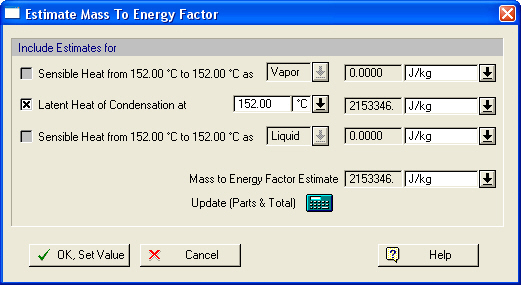

Since the heat provided (or absorbed) by a heat transfer agent is translated into sensible heat and latent heat (if there’s a phase transition), in the most general case, the three contributing energy amounts can be:
● Sensible heat from supply temperature to phase change temperature
● Latent heat for phase change
● Sensible heat from phase change temperature to exit temperature
As an example, consider the case of a super-heated steam that is returned to the utility system as a sub-cooled liquid.
The way to use this dialog, is to include the terms that are supposed to contribute to the energy transferred to (or from) the agent, then click on the “Update (Parts & Total)” calculator button.
This will compute a mass-to-energy factor and display it in the control above the button. If you agree to the computed value, then click on OK, Set Value and this will copy the mass-to-energy factor value and paste it in the proper field of the heat transfer agent definition dialog (see Heat Transfer Agent Properties Dialog: Properties tab).
Please note that the mass-to-energy factor will be the most important number when determining the unit price of an agent in mass or volume basis. More specifically, it represents the energy component of a heat transfer agent cost. There may be added cost due to ‘make-up’ material required to regenerate the agent. For a more detailed explanation of this cost and to see how the material and energy cost components together make up the final (total) cost of a heat transfer agent, see The life cycle and unit cost of a heat transfer agent.